four wheel drive CHEVROLET TRACKER 1995 Owners Manual
[x] Cancel search | Manufacturer: CHEVROLET, Model Year: 1995, Model line: TRACKER, Model: CHEVROLET TRACKER 1995Pages: 354, PDF Size: 18.24 MB
Page 51 of 354

Ignition Switch
I n 1 With the key in the
ignition switch, you
can turn the switch to
four positions:
I I
LOCK (A): The only position in which you can remove
the key. This locks your steering wheel, ignition and
automatic transmission. Press in the ignition switch as
you turn the top
of it toward you.
If you have an automatic transmission, the ignition
switch can't be turned
to LOCK unless the shift lever is
in the
PARK (P) position.
ACC (B): The position that you can operate your
electrical power accessories.
It unlocks the steering
wheel and ignition. Use this position if
your vehicle
must be pushed
or towed.
ON (C): The position that the switch returns to after you
start your engine and release the switch. The switch
stays in the
ON position when the engine is running. But
even when the engine is not running, you can use
ON to
operate your electrical power accessories and to display
some instrument panel warning and indicator lights.
START (D): The position that starts the engine. When
the engine starts, release the key. The ignition switch
will return to
ON for normal driving.
When the engine is not running,
ACC and ON allow you
to operate your electrical accessories, such as the radio
and ventilation fan.
A warning chime will sound if you open the driver's
door when the ignition is in
ACC or LOCK and the key
is in the ignition.
ProCarManuals.com
Page 56 of 354
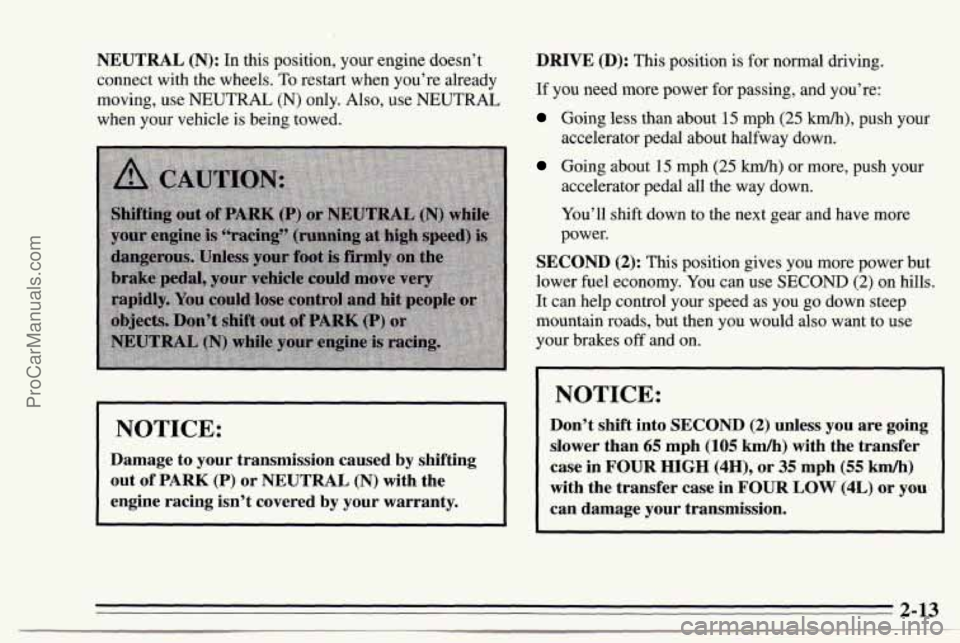
NEUTRAL (N): In this position, your engine doesn’t
connect with the wheels. To restart when you’re already
moving, use NEUTRAL
(N) only. Also, use NEUTRAL
when your vehicle is being towed.
NOTICE:
Damage to your transmission caused by shifting
out of PARK
(P) or NEUTRAL (N) with the
engine racing isn’t covered
by your warranty. DRIVE (D):
This position
is for normal driving.
If you need more power for passing, and you’re:
Going less than about 15 mph (25 km/h), push your
accelerator pedal about halfway down.
Going about 15 mph (25 kmk) or more, push your
accelerator pedal
all the way down.
You’ll shift down to the next gear and have more
power.
SECOND (2): This position gives you more power but
lower fuel economy. You can use SECOND
(2) on hills.
It can help control your speed as you go down steep
mountain roads,
but then you would also want to use
your brakes off and on.
NOTICE:
Don’t shift into SECOND (2) unless you are going
slower than
65 mph (105 kmh) with the transfer
case
in FOUR HIGH (4H), or 35 mph (55 km/h)
with the transfer case in FOUR LOW (4L) or you
can damage your transmission.
2-13
ProCarManuals.com
Page 57 of 354
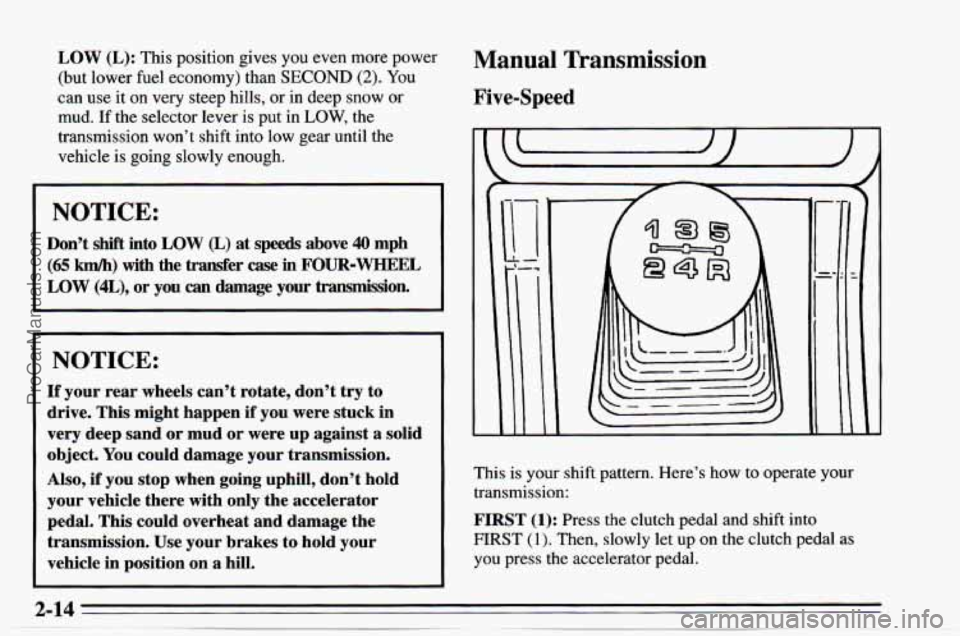
LOW (L): This position gives you even more power
(but lower fuel economy) than
SECOND (2). You
can use it on very steep hills, or in deep snow or
mud. If the selector lever is put in LOW, the
transmission won’t shift into low gear until the
vehicle is going slowly enough.
NOTICE:
Don’t shift into LOW (L) at speeds above 40 mph
(65 km/h) with the transfer case in FOUR-WHEEL
LOW (4L), or you can damage your transmission.
NOTICE:
If your rear wheels can’t rotate, don’t try to
drive. This might happen
if you were stuck in
very deep sand or mud or were up against a solid
object.
You could damage your transmission.
Also,
if you stop when going uphill, don’t hold
your vehicle there with only the accelerator
pedal. This could overheat and damage the
transmission. Use your brakes to hold your
vehicle in position on a hill.
Manual Transmission
Five-Speed
This is your shift pattern. Here’s how to operate your
transmission:
FIRST (1): Press the clutch pedal and shift into
FIRST
(1). Then, slowly let up on the clutch pedal as
you press the accelerator pedal.
ProCarManuals.com
Page 60 of 354
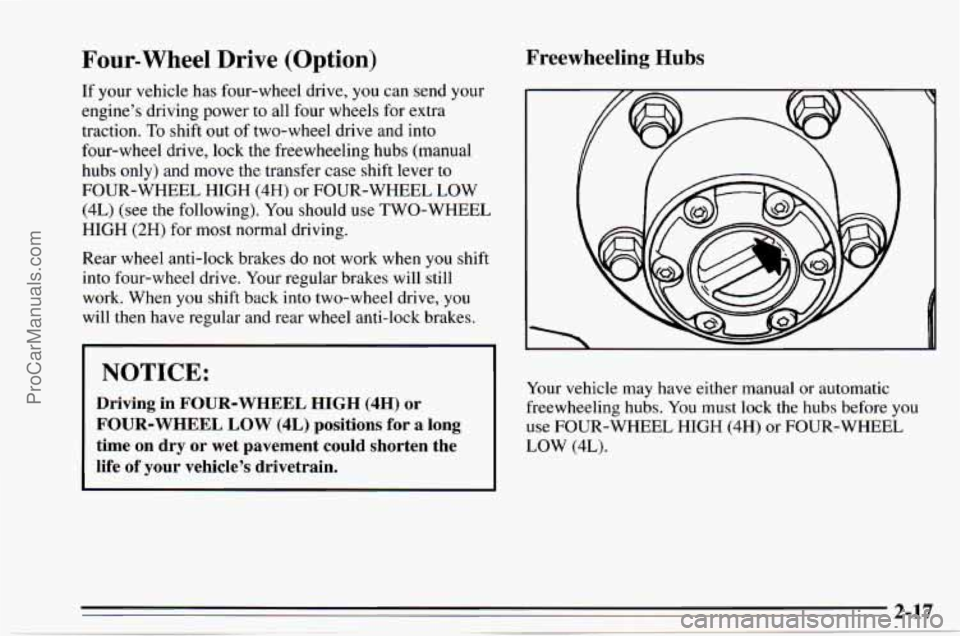
Four-wheel Drive (Option)
If your vehicle has four-wheel drive, you can send your
engine’s driving power to all four wheels for extra
traction.
To shift out of two-wheel drive and into
four-wheel drive, lock the freewheeling hubs (manual
hubs only) and move the transfer
case shift lever to
FOUR-WHEEL
HIGH (4H) or FOUR-WHEEL LOW
(4L) (see the following). You should use TWO-WHEEL
HIGH
(2H) for most normal driving.
Rear wheel anti-lock brakes
do not work when you shift
into four-wheel drive. Your regular brakes will still
work. When you shift back into two-wheel drive,
you
will then have regular and rear wheel anti-lock brakes.
NOTICE:
Driving in FOUR-WHEEL HIGH (4H) or
FOUR-WHEEL LOW (4L) positions for a long
time on dry or wet pavement could shorten the
life of your vehicle’s drivetrain.
Freewheeling Hubs
Your vehicle may have either manual or automatic
freewheeling hubs. You must
lock the hubs before you
use FOUR-WHEEL HIGH (4H) or FOUR-WHEEL
LOW (4L).
ProCarManuals.com
Page 61 of 354
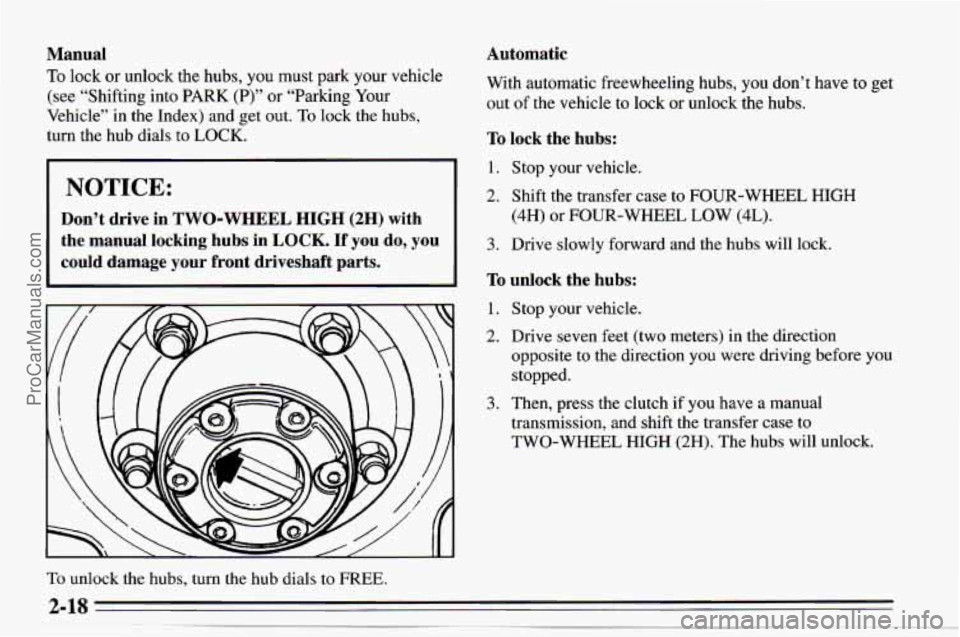
Manual
To lock or unlock the hubs, you must park your vehicle
(see “Shifting into
PARK (P)” or “Parking Your
Vehicle” in the Index) and get out.
To lock the hubs,
turn the hub dials
to LOCK.
NOTICE:
Don’t drive in TWO-WHEEL HIGH (2H) with
the manual locking hubs in
LOCK. If you do, you
could damage your front driveshaft parts.
To unlock the hubs, turn the hub dials to FREE.
Automatic
With automatic freewheeling hubs, you don’t have to get
out of the vehicle to lock or unlock the hubs.
To lock the hubs:
1. Stop your vehicle.
2. Shift the transfer case to FOUR-WHEEL HIGH
(4H)
or FOUR-WHEEL LOW (4L).
3. Drive slowly forward and the hubs will lock.
To unlock the hubs:
1. Stop your vehicle.
2. Drive seven feet (two meters) in the direction
opposite to the direction you were driving before you
stopped.
transmission, and shift the transfer case to
TWO-WHEEL HIGH (2H). The hubs will unlock.
3. Then, press the clutch if you have a manual
ProCarManuals.com
Page 62 of 354

Transfer Case
The transfer case shift lever is on the floor to the right of
the driver. Use this lever to shift into and out of
four-wheel drive. An indicator light comes on when the
transfer case is in FOUR-WHEEL
HIGH (4H) or
FOUR-WHEEL
LOW (4L).
TWO-WHEEL HIGH (2H): This setting is for driving
in most street
and highway situations. Your front axle is
not engaged in two-wheel drive.
FOUR-WHEEL HIGH (4H): This setting engages
your front axle
to help drive your vehicle. Use
FOUR-WHEEL HIGH (4H) when you need extra
traction, such as on wet or icy roads, or in
most off-road
situations.
NEUTRAL (N): Shift to this setting only when your
vehicle needs to be towed.
FOUR-WHEEL LOW (4L): This setting also engages
your front axle to give you extra traction, but should be
used only for driving downhill
or on slippery surfaces
when you're driving slower than
35 mph (55 km/h).
Remember that driving in FOUR-WHEEL HIGH (4H)
or FOUR-WHEEL LOW (4L)
may reduce fuel
economy. Also, driving in four-wheel drive on dry
pavement could cause your tires to wear faster and make
your transfer case harder
to shift.
2-19
ProCarManuals.com
Page 65 of 354
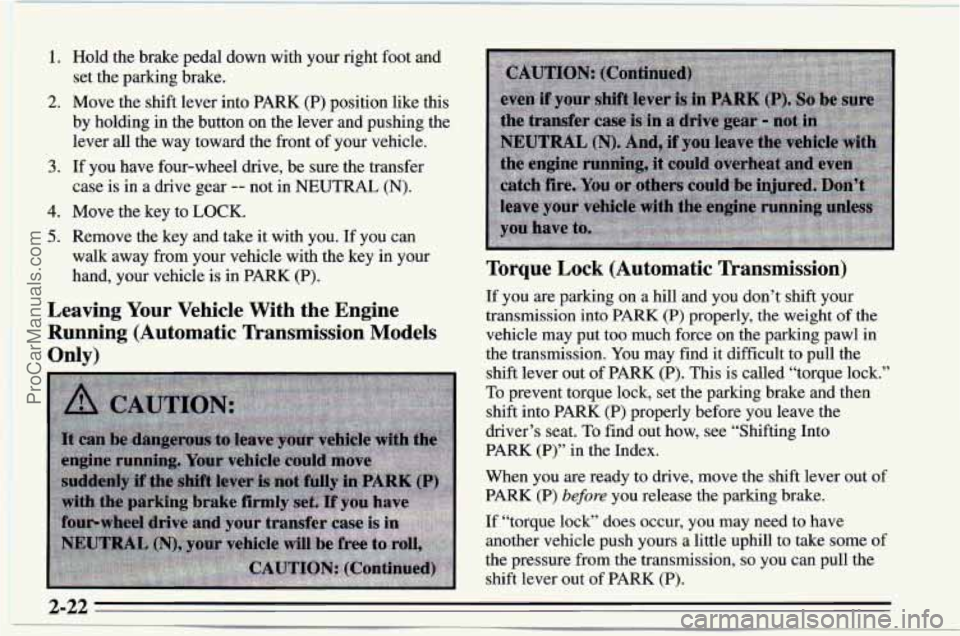
1.
2.
3.
4.
5.
Hold the brake pedal down with your right foot and
set the parking brake.
Move the shift lever into PARK
(P) position like this
by holding
in the button on the lever and pushing the
lever all the way toward the front of your vehicle.
If you have four-wheel drive, be sure the transfer
case is in a drive gear
-- not in NEUTRAL (N).
Move the key to LOCK.
Remove the key and take it with you. If you can
walk away
from your vehicle with the key in your
hand, your vehicle is in PARK (P).
Leaving Your Vehicle With the Engine
Running (Automatic Transmission Models
Only) Torque Lock (Automatic Transmission)
If you
are parking on a hill and you don’t shift your
transmission
into PARK (P) properly, the weight of the
vehicle may put too much force
on the parking pawl in
the transmission. You may find it difficult to pull the
shift lever out
of PARK (P). This is called “torque lock.”
To prevent torque lock, set the parking brake and then
shift into PARK (P) properly before you leave the
driver’s seat. To find out how, see “Shifting Into
PARK (P)” in the Index.
When you are ready to drive, move the shift lever out of
PARK (P)
before you release the parking brake.
If “torque lock” does occur, you may need to have
another vehicle push yours a little uphill to take some of
the pressure from the transmission,
so you can pull the
shift lever out of PARK
(P).
2-22
ProCarManuals.com
Page 67 of 354
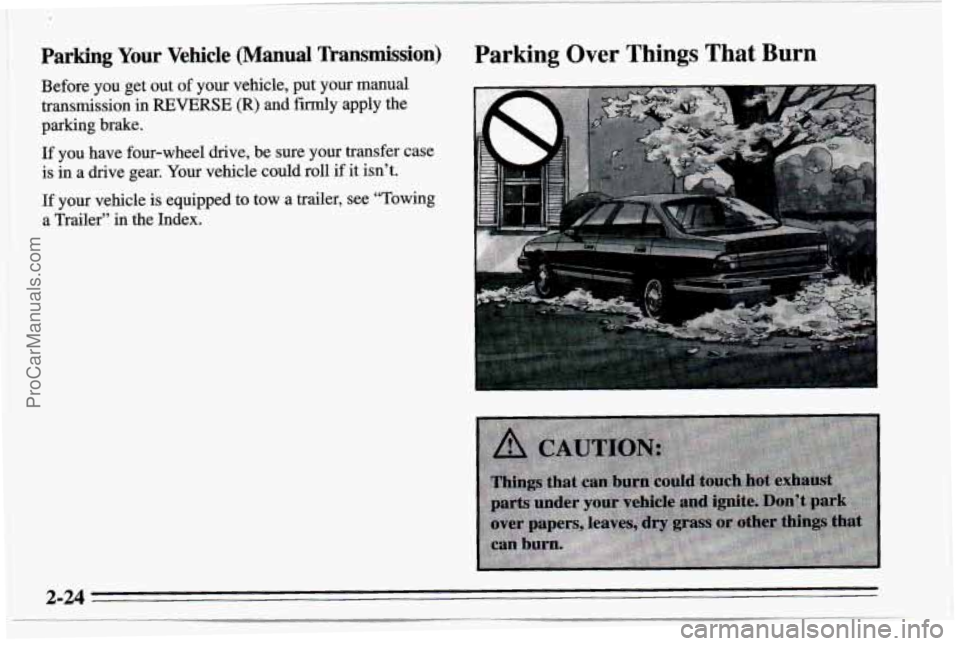
Parking Your Vehicle (Manual mansmission)
Before you get out of your vehicle, put your manual
transmission in
REVERSE (R) and firmly apply the
parking brake.
If you have four-wheel drive, be sure your transfer case
is in a drive gear. Your vehicle could roll
if it isn’t.
If your vehicle is equipped to tow a trailer, see “Towing
a Trailer” in the Index.
Parking Over Things That Burn
2-24
ProCarManuals.com
Page 69 of 354

Windows
If you have four-wheel drive and your transfer case is in
NEUTRAL
(N), your vehicle will be free to roll, even if
your shift lever is in
PARK (P). So, be sure the transfer
case
is in a drive gear -- not in NEUTRAL (N). Always
set your parking brake. Follow the proper steps to be
sure your vehicle won’t move. See “Shifting Into
PARK (P)” in the Index.
If you’re pulling a trailer, see “Towing a Trailer” in the
Index.
Manual Windows
Use the window crank to open and close each door
window.
Rear Swing-Out Side Windows
To open this window, pull the latch out and forward.
ProCarManuals.com
Page 132 of 354

A computer senses that the rear wheels are slowing
down.
If one of the rear wheels is about to stop rolling,
the computer will work the brakes at the rear wheels. It
is programmed to make the most
of available tire and
road conditions.
As you brake, your computer keeps receiving updates
on
rear wheel speed and controls braking pressure
accordingly. Remember:
Anti-lock doesn’t change the time you need
to get your foot up to the brake pedal. If you get too
close to the vehicle in front of you,
you won’t have time
to apply your brakes if that vehicle suddenly slows or
stops. Always leave enough room up ahead to stop, even
though
you have anti-lock brakes.
To Use Anti-Lock
Use rear-wheel anti-lock like regular brakes. You may
feel the brakes; vibrate, or you may notice some noise
outside your vehicle, but this is normal. Let anti-lock
work for
you, but remember: Your front wheels can still
stop rolling.
If that happens, release enough pressure on
the brakes to get the wheels rolling again
so that you can
steer.
With the four-wheel drive option, you won’t have
anti-lock brak.ing when
you shift into four-wheel drive.
But
you will have regular braking. When you shift back
into two-wheel drive,
you will have anti-lock again.
4-7
ProCarManuals.com